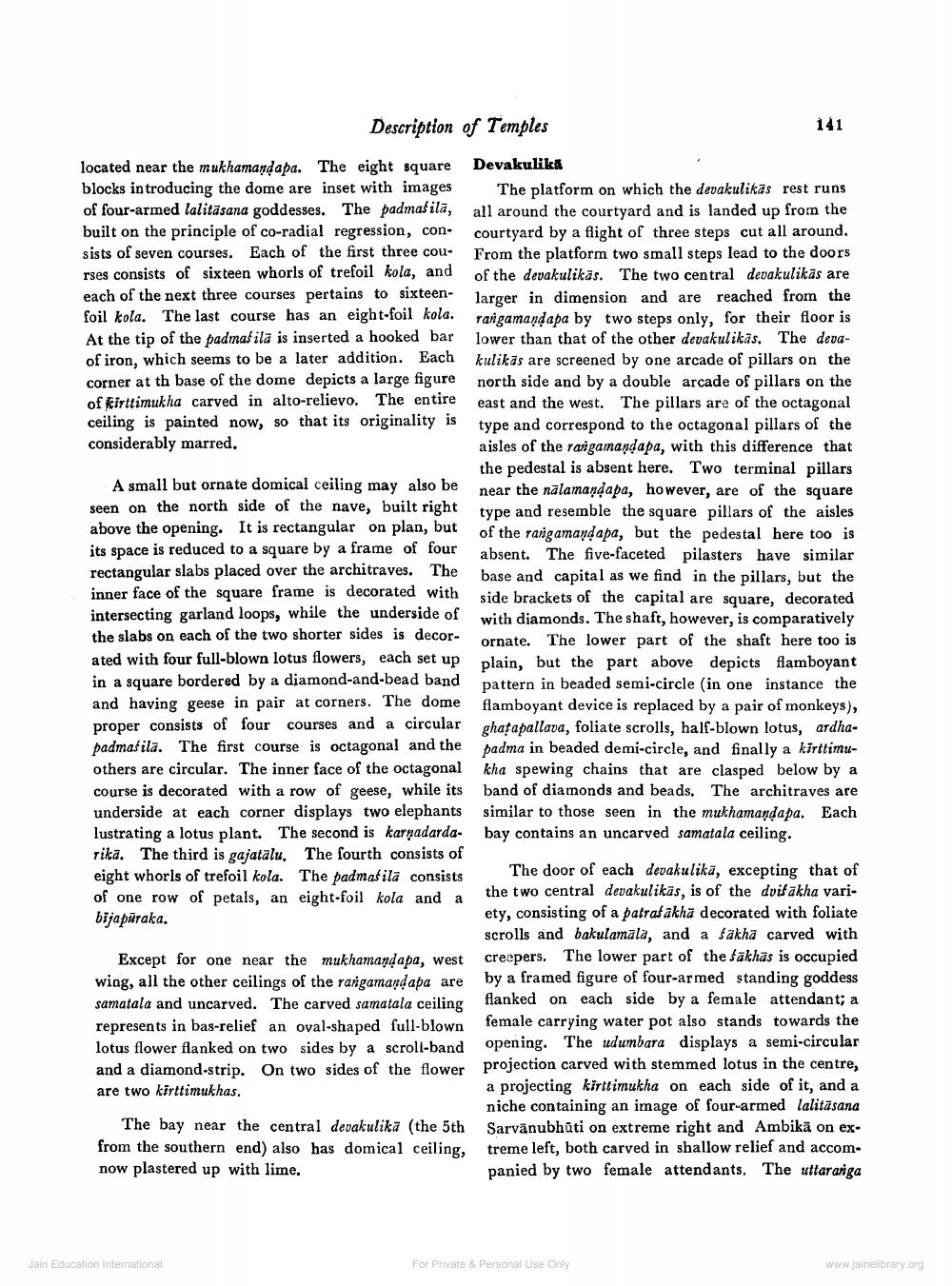________________
Description of Temples
141
located near the mukhamandapa. The eight square Devakulika blocks introducing the dome are inset with images The platform on which the devakulikās rest runs of four-armed lalitāsana goddesses. The padmašila, all around the courtyard and is landed up from the built on the principle of co-radial regression, con- courtyard by a flight of three steps cut all around. sists of seven courses. Each of the first three cou- From the platform two small steps lead to the doors rses consists of sixteen whorls of trefoil kola, and of the devakulikās. The two central devakulikās are each of the next three courses pertains to sixteen- larger in dimension and are reached from the foil kola. The last course has an eight-foil kola. rangamandapa by two steps only, for their floor is At the tip of the padmašila is inserted a hooked bar lower than that of the other devakulikās. The devaof iron, which seems to be a later addition. Each kulikās are screened by one arcade of pillars on the corner at th base of the dome depicts a large figure north side and by a double arcade of pillars on the of Kirttimukha carved in alto-relievo. The entire
east and the west. The pillars are of the octagonal
east and the west. The pillars ara e ceiling is painted now, so that its originality is type and correspond to the octagonal pillars of the considerably marred.
aisles of the rarigamandapa, with this difference that
the pedestal is absent here. Two terminal pillars A small but ornate domical ceiling may also be
near the nalamandapa, however, are of the square seen on the north side of the nave, built right
type and resemble the square pillars of the aisles above the opening. It is rectangular on plan, but of the rangamandapa, but the pedestal here too is its space is reduced to a square by a frame of four
absent. The five-faceted absent. The
pilasters have similar rectangular slabs placed over the architraves. The base and capital as we find in the pillars, but the inner face of the square frame is decorated with
side brackets of the capital are square, decorated intersecting garland loops, while the underside of
with diamonds. The shaft, however, is comparatively the slabs on each of the two shorter sides is decor- ornate. The lower part of the shaft here too is ated with four full-blown lotus flowers, each set up plain, but the part above depicts flamboyant in a square bordered by a diamond-and-bead band pattern in beaded semi-circle (in one instance the and having geese in pair at corners. The dome flamboyant device is replaced by a pair of monkeys), proper consists of four courses and a circular ghatapallava, foliate scrolls, half-blown lotus, ardhapadmašila. The first course is octagonal and the padma in beaded demi-circle, and finally a körttimuothers are circular. The inner face of the octagonal kha spewing chains that are clasped below by a course is decorated with a row of geese, while its band of diamonds and beads. The architraves are underside at each corner displays two elephants similar to those seen in the mukhamandapa. Each lustrating a lotus plant. The second is karmadarda. bay contains an uncarved samatala ceiling. rika. The third is gajatalu. The fourth consists of eight whorls of trefoil kola. The padmašila consists
The door of each devakulika, excepting that of of one row of petals, an eight-foil kola and a
the two central devakulikās, is of the dvišakha varibijapūraka.
ety, consisting of a patrašakha decorated with foliate
scrolls and bakulamala, and a fakha carved with Except for one near the mukhamandapa, west creepers. The lower part of the sākhas is occupied wing, all the other ceilings of the rangamandapa are by a framed figure of four-armed standing goddess samatala and uncarved. The carved samatala ceiling flanked on each side by a female attendant; a represents in bas-relief an oval-shaped full-blown female carrying water pot also stands towards the lotus flower flanked on two sides by a scroll-band opening. The udumbara displays a semi-circular and a diamond-strip. On two sides of the flower projection carved with stemmed lotus in the centre, are two kirttimukhas.
a projecting kirttimukha on each side of it, and a
niche containing an image of four-armed lalitäsana The bay near the central devakulika (the 5th Sarvānubhūti on extreme right and Ambikā on ex. from the southern end) also has domical ceiling, treme left, both carved in shallow relief and accomnow plastered up with lime.
panied by two female attendants. The uttaraniga
Jain Education International
For Private & Personal use only
www.jainelibrary.org




